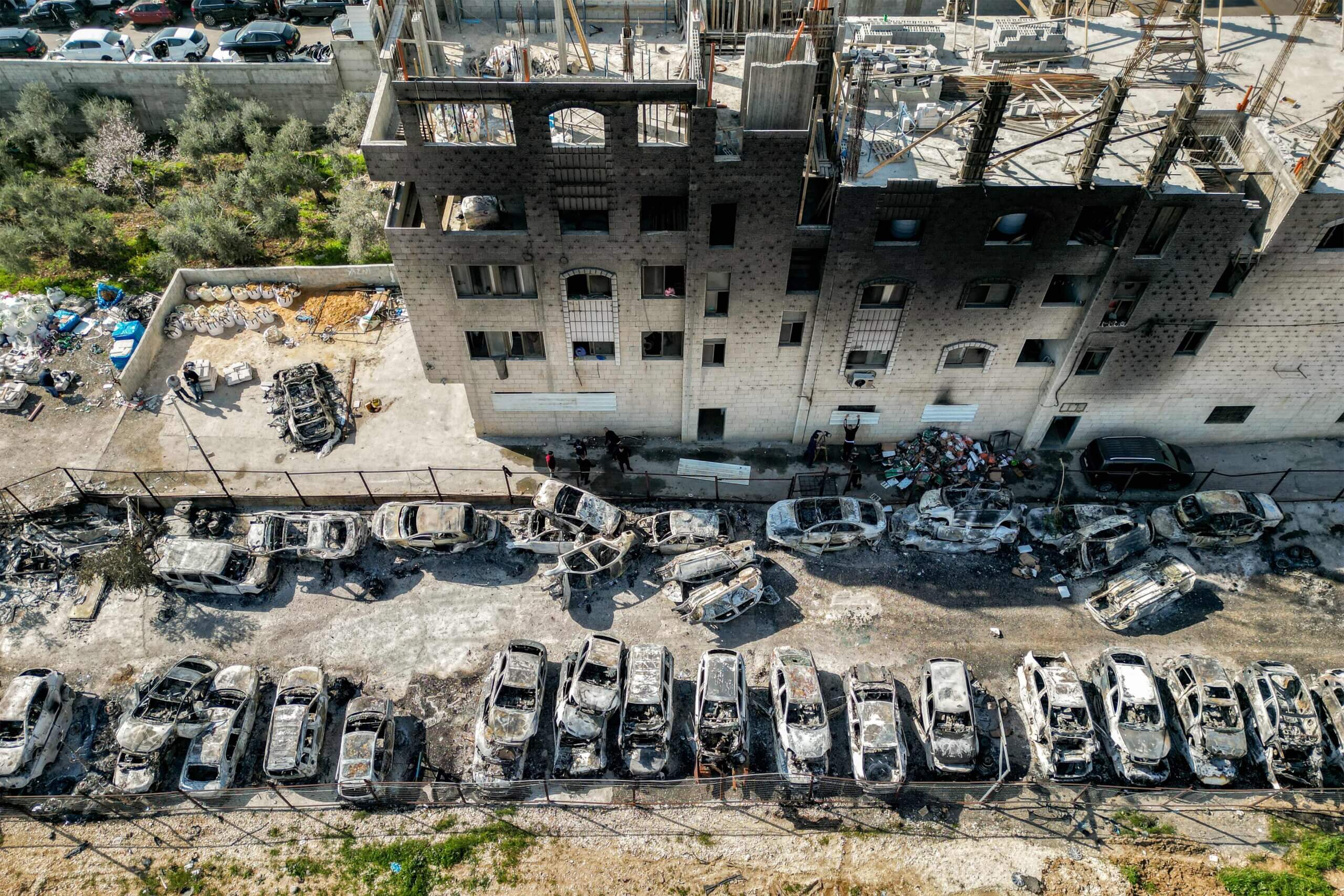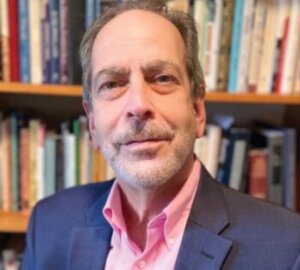Pogrom? Terrorism? What do we call what happened in Huwara?
Jewish settlers attacked a Palestinian village to avenge the deaths of two brothers. A debate over language and history followed

(JTA illustration by Mollie Suss)
(JTA) — On Sunday, after a Palestinian gunman shot and killed two Israeli brothers in the West Bank, Jewish settlers rioted in the nearby Palestinian town of Huwara, burning cars and buildings. A Palestinian was killed and dozens were injured.
Israeli Prime Minister Benjamin Netanyahu condemned the Jewish rioters for “taking the law in their own hands,” but many observers — including Abraham Foxman, director emeritus of the the Anti-Defamation League — used stronger language, calling the attacks a “pogrom.”
The use of the word, which most famously refers to a wave of anti-Jewish violence in the Russian empire beginning in the late 19th century, in turn became the subject of debate. Does using “pogrom” co-opt Jewish history unfairly and inaccurately by suggesting Jews are no better than their historical persecutors? Does avoiding the term mean Israel and its supporters are not taking sufficient responsibility for the actions of its Jewish citizens?
The debate is not just about language, but about controlling the narrative. Political speech can minimize or exaggerate events, put them in their proper context or distort them in ways that, per George Orwell, can “corrupt thought.”
We asked historians, linguists and activists to consider the word pogrom, and asked them what politicians, journalists and everyday people should call what happened at Huwara. Their responses are below.
Sidestepping the real issue
Dr. Jeffrey Shandler
Distinguished Professor, Department of Jewish Studies, Rutgers University
The meanings of the word “pogrom” in different languages are key here. In Russian, it means a massacre or raid, as it does in Yiddish; in neither language is it understood as specifically about violence against Jews. The Oxford English Dictionary concurs that pogrom means an “organized massacre… of any body or class,” but notes that, in the English-language press, it was first used mostly to refer to anti-Jewish attacks in Russia, citing examples from 1905-1906.
Therefore, though the association of pogrom with violence targeting Jews is widely familiar, its meaning is broader.
That said, because of English speakers’ widely familiar association of the term with Jews as victims, to use pogrom to describe violence perpetrated by Jews is provocative. As to whether it is appropriate to refer to recent attacks by Jewish settlers on Palestinians, it seems to me that this question sidesteps the more important question of whether the actions being called pogroms are appropriate.
Call it what it is: “settler terrorism”
Sara Yael Hirschhorn
Author, “City on a Hilltop: American Jews and the Israeli Settler Movement”
Let me say first with a loud and clear conscience: What happened in Huwara was abhorrent, immoral, and unconscionable and certainly was not committed in my name.
But to paraphrase Raymond Carver’s famous formulation: How do we talk about it when we talk about Huwara? What kind of descriptive and analytical framework can adequately and contextually interpret that horrific event?
The shorthand of choice seems to be “pogrom” — but it isn’t clear that all who deploy the term are signifying the same thing. For some, pogrom is a synonym for pillage, rampage, fire, property damage and violence in the streets — a one-word general summary of brutal acts. For others, pogrom refers to vigilante justice, an abbreviated story of the non-state or non-institutional actors and their motivations.
More specifically, however, pogrom is seemingly being mobilized as a metaphor to Jewish history, juxtaposing the Jewish victims of yesterday to the Jewish-Israeli perpetrators of today, an implicit analogy to the prelude to the Shoah, recasting Zionists as organized bands of genocidaires (with or without regime sponsorship) like the Cossacks, the Nationalist Fronts or even the Einsatzgruppen. Some would use the word to incorporate all three meanings (and more).
As a historian, I am troubled by the haphazard and harmful use of terms that are attached to a specific time and place — such as the thousand-year history of Jews in the Rhinelands and Eastern Europe, with many layers of imperial, national, local, economic and religious forces that precipitated these events — in such an ahistorical manner. Nor do I find the parallels between Zionists and Nazis to be historically careful (if deliberately offensive) — the State of Israel is committing crimes in the West Bank, but not a genocide. The equivalence also all too easily and incorrectly grafts tropes of racism and white supremacy drawn from American history into the West Bank’s soil.
So what to say about Huwara? Israel — for reasons both political and lexiconographical — has failed to consistently adopt a term for such attacks. (Often the euphemism of “errant weeds” who are “taking matters into their own hands” is the choice of Knesset politicians.) To my mind, the best term is “settler terrorism,” which puts Jewish-Israeli acts on par with Palestinian terrorism. It should also mean that these actions merit the same consequences under the occupation like trial, imprisonment, home demolition and other deterrents enforced against all those who choose the path of violence.
Last but not least, a pogrom was historically an unpunished crime against humanity that led only to war and annihilation. Don’t we aspire for more in Israel/Palestine?
Palestinians call it “ethnic cleansing”
Ibrahim Eid Dalalsha
Director, Horizon Center for Political Studies and Media Outreach, Ramallah, and member of Israel Policy Forum’s Critical Neighbors task force
Palestinians generally view and describe what happened during Sunday’s Huwara attacks as “racist hate crimes seeking to destroy and dispossess the Palestinian people of their homes and properties.” While no specific term has been used to describe these attacks, it was likened to the barbaric and savage invasion of Baghdad by Hulagu, the 13th-century Mongol commander.
Palestinian intellectuals tend to use “ethnic cleansing,” savage and barbaric ethnically motivated violence against innocent civilians, as another way of referring to these attacks. When such events include killing, Palestinian politicians and intellectuals tend to use the term massacre, or “majzara,” to underline the irrational and indiscriminate violence against defenseless civilians. I don’t think the term “pogrom” and its historic connotation are widely known to most people here. From a Palestinian perspective, using such terms, including “Holocaust,” is not considered a mistake. In fact, even using “Holocaust“ to describe violence against Palestinian civilians in and around 1948 was not considered a mistake until very recently when it caused such a saga for Palestinian Authority President Mahmoud Abbas in Germany.

In the name of historical accuracy
Rukhl Schaechter
Yiddish Editor, The Forward
The recent attacks by Israeli settlers on Palestinians in Huwara are abhorrent. I commend those in Israel calling them peulot teror, “actions of terror,” and I trust that the perpetrators will be brought to justice. But these riots were not pogroms.
The word pogrom refers to one of the many violent riots and subsequent massacres of Jews in Eastern Europe between the 17th and 20th centuries. These attacks were committed by local non-Jewish, often peasant populations. They were instigated by rabble-rousers like Bogdan Chmielnicki, who led a Cossack and peasant uprising against Polish rule in Ukraine in 1648 and ended up destroying hundreds of Jewish communities. According to eyewitnesses, the attackers also committed atrocities on pregnant women.
Note that the massacres of Jews carried out by the Nazis, and the murders of Armenians by the Turkish government at the turn of the 20th century — as horrific as they were — were never called pogroms because in both cases, there was a government behind it. In the name of historic accuracy, let’s continue to use the word pogrom solely for mob attacks on and massacres of Jews.
When the Poles banned “pogrom”
Samuel D. Kassow
Professor of History, Trinity College, Hartford, Connecticut
In Poland in the late 1930s, altercations between a Jew and a Pole sometimes ended with either the Jew or the Pole getting badly hurt or even killed. When the victim was a Pole, mobs of Poles rampaged through Jewish neighborhoods smashing windows, looting shops and often beating or even killing Jews. Poles often held Jews collectively responsible for the death of one of their own. This happened in Przytyk, Minsk-Mazowieck, Grodno and other places. Jews called these riots “pogroms,” which they were. But the Polish government banned use of the term in the press. After all, “pogrom” was a Russian word, and “pogroms” happened only in a place characterized by barbarism and ignorance. Since Poland was not Russia, and since Poles were eminently civilized, logically speaking, pogroms simply did not take place in Poland. What happened in these towns were to be called “excesses” (zajscia). But certainly not pogroms!
I take it that since we Jews are so civilized, we too are incapable of pogroms. So should we label what these settlers did “‘excesses”? Or perhaps we should take a deep breath and call them pogroms?
A Jewish, but not exclusive, history
Henry Abramson
Historian
The word “pogrom” is rooted in time and place, although the type of violence it describes is as old as human history. It is a Russian word, but it entered the English language in the late 19th century through the medium of Yiddish-speakers, outraged at the wave of antisemitic disturbances that surged under rule of the last tsar of the Russian Empire, Nicholas II. Russians themselves used a variety of words for the ugly phenomenon, with translations like “riot” or “persecution,” but the term “pogrom” proved the most evocative: the Slavic prefix “po” suggests a directed attack, and the root “grom” is the word for “thunder.” A pogrom, therefore, meant a focused point where a great deal of energy was dissipated in a single dramatic act of violence.
The focused point, in the context of that dark history, was the civilian Jewish population in the tiny shtetls that dotted the Pale of Settlement. In this regard the word could be used to encompass attacks on Jewish populations from as long ago as the year 38 in Alexandria, Egypt. It does not, however, have any specific designation to indicate that Jews are the victims.
This article originally appeared on JTA.org.
















